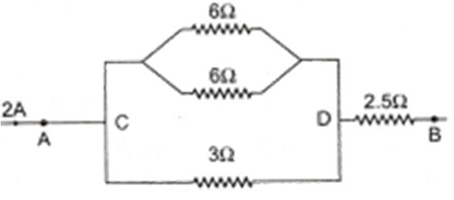 Multiple Choice Questions
Multiple Choice QuestionsYou are given resistance wire of length 50 cm and a battery of negligible resistance. In which of the following cases is the largest amount of heat generated?
When the wire is connected to the battery directly
When the wire is divided into two parts and both the parts are connected to the battery in parallel.
When the wire is divided into four parts and all the four parts are connected to the battery in parallel.
When only half of the wire is connected to the battery
When a voltmeter connected across the terminals of cell, measures 5 V and an ammeter connected measures 10 A. A resistance of 2 Ω is connected across the terminal of the cell. The current flowing through this resistance is
7.5amp
5.0amp
2.5amp
2.0amp
In a neon discharge tube 2.9 x 10 Ne18 ions move to be the right per second while 1.2 x 108 electron move to the left per second electric charge is 1.6 x 10-19C. The current in discharge tube is
0.66A towards left
0.66 A towards left
1A towards right
Zero
Two equal resistances R are joined with voltage source V in (i)series (ii)parallel, the ratio of electrical power consumed in two cases will be
1:4
4:1
2:1
1:2
When a resistance of α Ω is connected at the ends of a battery, its potential difference decreases from 40 V to 30V. The internal resistance of the battery is
3Ω
6Ω
1.5Ω
4Ω
The equivalent resistance and potential difference between A and B for the circuit
respectively are

4Ω, 8V
8Ω, 4V
2Ω, 2V
16Ω, 2V
A.
4Ω, 8V
The resistance in parallel given by
A wire of resistance R is divided in equal parts, then these parts are joined in parallel, the equivalent resistance of the combination will be
nR
When a certain current is passed in the circuit as shown in figure, 10 kcal of heat is produced in 5 Ω resistance. How much heat is produced in 4 Ω resistance?

4 kcal
2 kcal
5 kcal
3 kcal
In the given circuit, what will be the equivalent resistance between the points A and B ?

10 / 3 Ω
20 / 3 Ω
10 / 5 Ω
5 Ω
